|
|
| (24 intermediate revisions not shown) |
| Line 1: |
Line 1: |
| - | {{Beerdragons}} | + | {{UC_Chile4}} |
| | + | |
| | + | == Penta UC == |
| | + | <html><img src = "https://static.igem.org/mediawiki/2012/4/44/Pentauc1_uc_chile.jpg" width= "300" align="right" style ="margin:15px"></html> |
| | + | The Talents Development and Study Program at Catholic University (PENTA UC for its initials in spanish) aims to educate and form creative and proactive kids and to reinforce their passion for knowledge. At the same time the PENTA program helps to enrich their personal and social maturation process through the development of confidence in themselves and their capacities, together with an ethical and socially responsible attitude. |
| | + | |
| | + | Through a curriculum of multiple disciplines and practical workshops lead by UC professors and students the program gives kids from socially disadvantaged contexts the opportunity to develop their potential. |
| | + | |
| | + | One of the courses, called “What if Dr. Frankenstein lived today?” is designed to introduce 13 year old kids to the practical and theoretical fundamentals of genetic engineering while addressing ethical questions in order to understand how it is possible to work with genes and use them for the benefit of mankind. |
| | + | |
| | + | This course happened to be guided by Ariel Herrera, a graduate student who is pursuing his Ph.D in the lab next to ours. We agreed that it would be great to explain the Central Dogma of molecular biology through a practical demonstration with recombinant E.coli colonies expressing fluorescent proteins and pigments. |
| | + | |
| | + | After a brief and interesting introduction by B. Pollak about plasmids, cloning and colony isolation, each of us went on to show a group of 5 kids the picking and striking of bacterial colonies under sterile and safe conditions. |
| | + | |
| | + | <html><img src = "https://static.igem.org/mediawiki/2012/d/d2/Pentauc2_uc_chile.jpg" width= "300" align="left" style ="margin:15px"></html>While explaining in simple terms how we obtained purple, green and red bacteria with Violacein synthesis pathway, GFP and RFP genes respectively, the young fellows were given freedom to “paint” with these cells in LB plates (check the results below!) |
| | + | |
| | + | After that, we showed them how to visualize the colonies under UV light. |
| | + | Finally, they were able to identify the differences between green autotrophic bacteria (our beloved Synechocystis PCC6803) and a heterotrophic one (Top10 E.coli) and how that is related to the growing conditions and media. |
| | + | GFP recombinant chimaeric-corpse engineered H. sapiens |
| | + | As an iGEM team we felt the experience very important to us because we could share our passion for science with kids that do not have many opportunities to enjoy molecular biology. Also, we could finally leave our tasks for a while and see the reality that surrounds us. This is an eye opener and definitely will help us keep things in perspective. We are extremely happy and grateful for contributing at least for just a few hours to the formation of the future scientists of our country. |
| | | | |
| - | == Ingenia Fair
| |
| | | | |
| | == INGENIA fair == | | == INGENIA fair == |
| Line 9: |
Line 27: |
| | And us. | | And us. |
| | | | |
| - | [[File:UC_Chile-Ingenia1.png|center|600 px]]
| + | <html><img src = "https://static.igem.org/mediawiki/2012/4/44/UC_Chile-Ingenia1.png" width= "600" align="right" style ="margin:15px"></html> |
| - | | + | |
| | | | |
| | I talked to the people in our alumni center, and they were thrilled about the idea of having us there. You see, biotechnology and bioengineering in general don’t get much of a spotlight in our faculty. Most engineers hate biology to their guts, and chemistry kind of makes them barf. I think it’s the lab alcohol, reminding them what they did last summer. And well, every summer. | | I talked to the people in our alumni center, and they were thrilled about the idea of having us there. You see, biotechnology and bioengineering in general don’t get much of a spotlight in our faculty. Most engineers hate biology to their guts, and chemistry kind of makes them barf. I think it’s the lab alcohol, reminding them what they did last summer. And well, every summer. |
| Line 51: |
Line 68: |
| | If you and your team have the chance to participate in a similar event, go for it! It’s a great way to get students to know about your projects, iGEM, and synthetic biology in general. Remember to have some nice handouts and a flashy poster. That, or get there dressed up as bacteria, I don’t know! Whatever floats your boat… and helps you get new recruits! | | If you and your team have the chance to participate in a similar event, go for it! It’s a great way to get students to know about your projects, iGEM, and synthetic biology in general. Remember to have some nice handouts and a flashy poster. That, or get there dressed up as bacteria, I don’t know! Whatever floats your boat… and helps you get new recruits! |
| | | | |
| - | == Penta UC ==
| |
| | | | |
| - | Human Practices: PENTA_UC
| |
| | | | |
| - | The Talents Development and Study Program at Catholic University (PENTA UC for its initials in spanish) aims to educate and form creative and proactive kids and to reinforce their passion for knowledge. At the same time the PENTA program helps to enrich their personal and social maturation process through the development of confidence in themselves and their capacities, together with an ethical and socially responsible attitude.
| |
| | | | |
| - | Through a curriculum of multiple disciplines and practical workshops lead by UC professors and students the program gives kids from socially disadvantaged contexts the opportunity to develop their potential.
| |
| | | | |
| - | One of the courses, called “What if Dr. Frankenstein lived today?” is designed to introduce 13 year old kids to the practical and theoretical fundamentals of genetic engineering while addressing ethical questions in order to understand how it is possible to work with genes and use them for the benefit of mankind.
| |
| | | | |
| - | This course happened to be guided by Ariel Herrera, a graduate student who is pursuing his Ph.D in the lab next to ours. We agreed that it would be great to explain the Central Dogma of molecular biology through a practical demonstration with recombinant E.coli colonies expressing fluorescent proteins and pigments.
| |
| | | | |
| - | After a brief and interesting introduction by B. Pollak about plasmids, cloning and colony isolation, each of us went on to show a group of 5 kids the picking and striking of bacterial colonies under sterile and safe conditions.
| + | == CONEIB (Congreso Nacional de Estudiantes de Ingeniería en Biotecnología)== |
| | | | |
| - | While explaining in simple terms how we obtained purple, green and red bacteria with Violacein synthesis pathway, GFP and RFP genes respectively, the young fellows were given freedom to “paint” with these cells in LB plates (check the results below!)
| + | We are proud to announce that our project got selected for the annual biotechnology students congress to be held in Antogasta, Chile from October 17 -19. |
| | | | |
| - | After that, we showed them how to visualize the colonies under UV light.
| + | <html> |
| - | Finally, they were able to identify the differences between green autotrophic bacteria (our beloved Synechocystis PCC6803) and a heterotrophic one (Top10 E.coli) and how that is related to the growing conditions and media.
| + | Here is<a href="http://www.congresobiotecnologia.cl/" target="_blank"> the official web page of the event!</a></html> (in Spanish). |
| - | GFP recombinant chimaeric-corpse engineered H. sapiens
| + | |
| - | As an iGEM team we felt the experience very important to us because we could share our passion for science with kids that do not have many opportunities to enjoy molecular biology. Also, we could finally leave our tasks for a while and see the reality that surrounds us. This is an eye opener and definitely will help us keep things in perspective. We are extremely happy and grateful for contributing at least for just a few hours to the formation of the future scientists of our country.
| + | |
| | + | {{UC_Chilefooter}} |

Penta UC
 The Talents Development and Study Program at Catholic University (PENTA UC for its initials in spanish) aims to educate and form creative and proactive kids and to reinforce their passion for knowledge. At the same time the PENTA program helps to enrich their personal and social maturation process through the development of confidence in themselves and their capacities, together with an ethical and socially responsible attitude.
The Talents Development and Study Program at Catholic University (PENTA UC for its initials in spanish) aims to educate and form creative and proactive kids and to reinforce their passion for knowledge. At the same time the PENTA program helps to enrich their personal and social maturation process through the development of confidence in themselves and their capacities, together with an ethical and socially responsible attitude.
Through a curriculum of multiple disciplines and practical workshops lead by UC professors and students the program gives kids from socially disadvantaged contexts the opportunity to develop their potential.
One of the courses, called “What if Dr. Frankenstein lived today?” is designed to introduce 13 year old kids to the practical and theoretical fundamentals of genetic engineering while addressing ethical questions in order to understand how it is possible to work with genes and use them for the benefit of mankind.
This course happened to be guided by Ariel Herrera, a graduate student who is pursuing his Ph.D in the lab next to ours. We agreed that it would be great to explain the Central Dogma of molecular biology through a practical demonstration with recombinant E.coli colonies expressing fluorescent proteins and pigments.
After a brief and interesting introduction by B. Pollak about plasmids, cloning and colony isolation, each of us went on to show a group of 5 kids the picking and striking of bacterial colonies under sterile and safe conditions.
 While explaining in simple terms how we obtained purple, green and red bacteria with Violacein synthesis pathway, GFP and RFP genes respectively, the young fellows were given freedom to “paint” with these cells in LB plates (check the results below!)
While explaining in simple terms how we obtained purple, green and red bacteria with Violacein synthesis pathway, GFP and RFP genes respectively, the young fellows were given freedom to “paint” with these cells in LB plates (check the results below!)
After that, we showed them how to visualize the colonies under UV light.
Finally, they were able to identify the differences between green autotrophic bacteria (our beloved Synechocystis PCC6803) and a heterotrophic one (Top10 E.coli) and how that is related to the growing conditions and media.
GFP recombinant chimaeric-corpse engineered H. sapiens
As an iGEM team we felt the experience very important to us because we could share our passion for science with kids that do not have many opportunities to enjoy molecular biology. Also, we could finally leave our tasks for a while and see the reality that surrounds us. This is an eye opener and definitely will help us keep things in perspective. We are extremely happy and grateful for contributing at least for just a few hours to the formation of the future scientists of our country.
INGENIA fair
The Faculty of Engineering of our university throws this cool innovation + entrepreneurship fair every year for the last two years. No wait, just the last year. And this one. Okay, so it’s not tradition yet. But it will be. Trust me on this one.
This fair, called INGENIA (a witty pun with Ingeniar, wich would be the verb form of engineering in Spanish) brings some really amazing guests to our yard (huh), including Google, Un techo para chile, Start-up Chile, our Deen and almost every teacher of the faculty who had something amazing to talk about.
And us.

I talked to the people in our alumni center, and they were thrilled about the idea of having us there. You see, biotechnology and bioengineering in general don’t get much of a spotlight in our faculty. Most engineers hate biology to their guts, and chemistry kind of makes them barf. I think it’s the lab alcohol, reminding them what they did last summer. And well, every summer.
Back to my point.
When we got the chance of having a booth and a round table for talking about synthetic biology, we couldn’t be happier –and prouder! Making this study-machines (or party-machines, it depends) interested in something other than their specialization field is our own little mission impossible. So when we (I say we, but it was actually our own architect, Rolando, who had to design and design for hours while I sent him about a hundred of versions of the text) decided to make the most amazing posters and handouts, so that at least our stand could be a little flashy. I mean, guys. We’re competing with investigation teams that bring food and wine and beer to their stands.
We had pipettes. I sincerely thought we were screwed.
These beauties here are our handouts and poster, respectively. Pretty, huh?
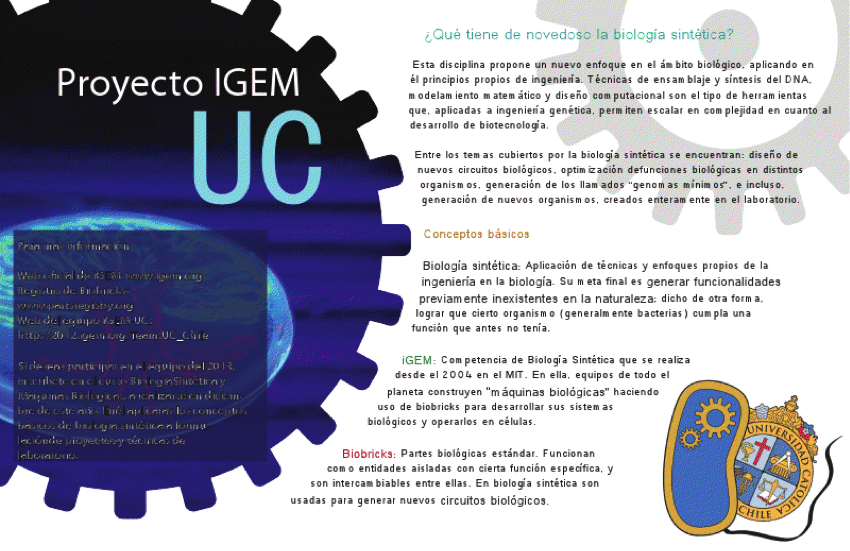
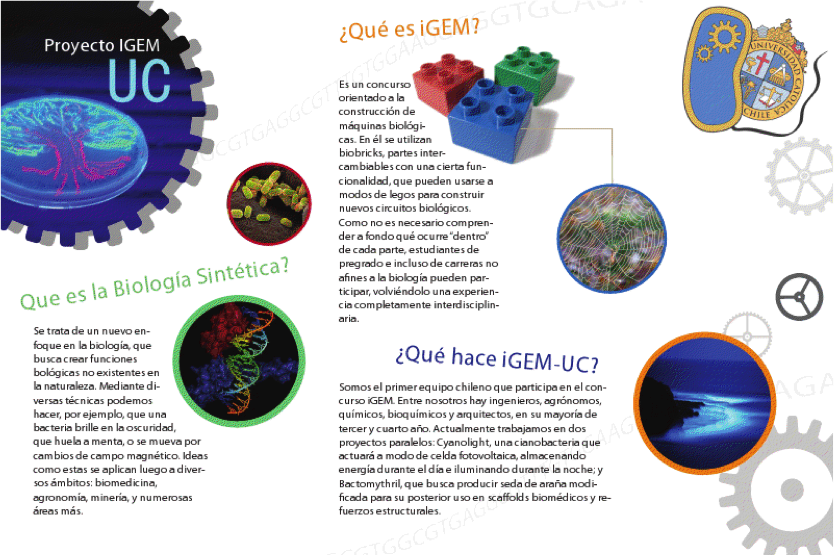
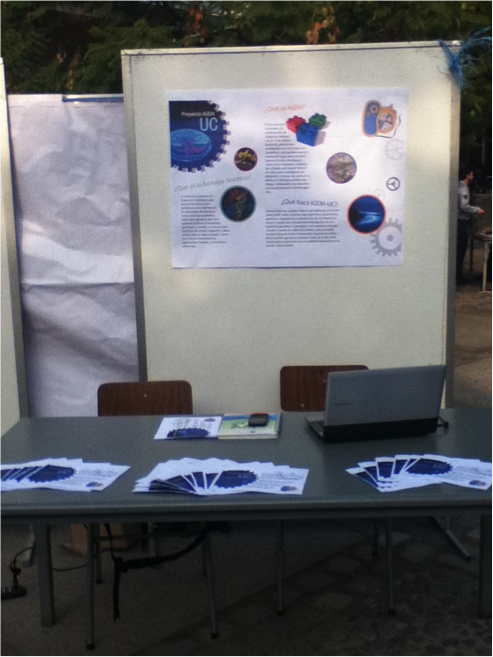
Ok, so we had amazing material. That alone should be enough to make our little booth pretty amazing, right?
Yeah. Not so much.
We also needed PEOPLE.
By 9:49 I was definitely panicking. I had talked to the amazing total of ONE person, and only because he was offering organic chips from his stand. Damn the people who can bring food to their booth. It’s not fair. We could offer bread with luminescent fungus if we wanted okay so just leave us alone.
Anyway. The booth was empty and my nerves were definitely on the edge, but everything changed when the fire nation attacked the 9:50 recess came.
You can always see people flooding out of their classrooms at that exact hour, but this time it was different. We were right in the middle of their trajectory. So they HAD to stop by. And luckily, they did!
We were there for about six hours. We had a little list for people who wanted to receive information about the competition and our projects. Bets came and went through the team members, and the highest bidder said there was no way we could get past twenty people (our faculty is not that big, mind you).
WE HAD 32. 32! AND THEY WERE ALL REAL PEOPLE, NO ANNITA BATHS OR ANYTHING OF SORTS ON THE LIST, I CHECKED.
IT WAS AWESOME.
AWESOME, I SAY.
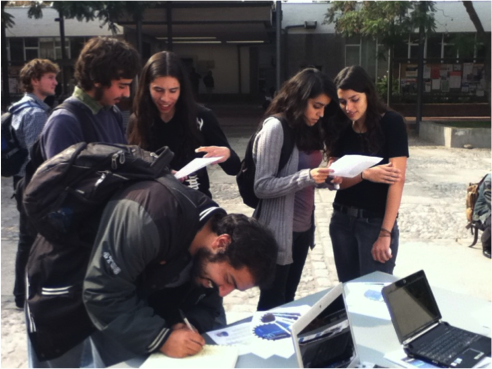
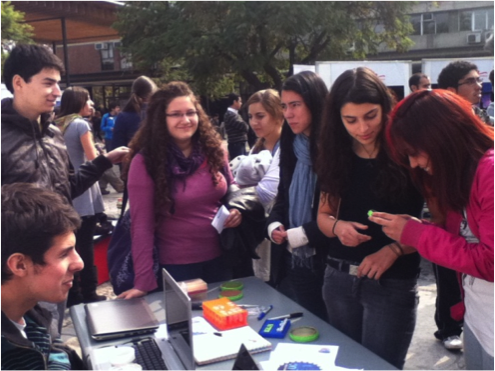
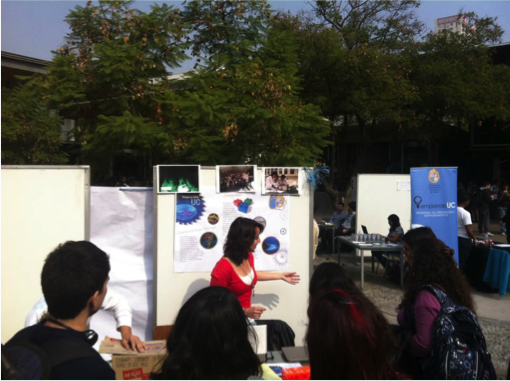
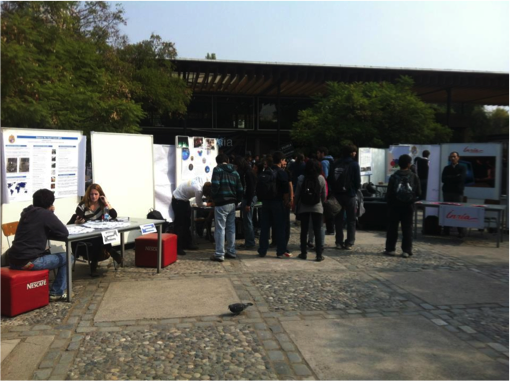
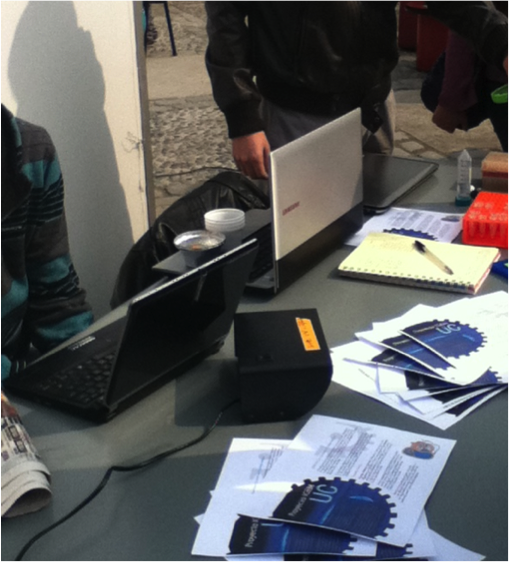
Most of the people we talked to were engineers specializing in biotechnology, though we did get others interested in math, computer science and mechanical engineering. If they really make it to next year’s team I highly advise you to watch out for them. Awesome interdisciplinary team approaching!
Some of them were really interested in going to the lab to see the results of the projects we talked so much about. If you can do that in your school too, it’s a sure way to interest indecisive people. After all, je pense donc je suis is much more like je vois donc il est, right?
Look at this! We even had the second fullest booth of the fair at some point of the afternoon! We couldn’t beat Google. They had google pencils. I got like five. They were awesome.
It was an amazing day, really.
The next day, we had a round table session to discuss synthetic biology and its influence in real life situations, mostly applied to our life as students. We were filmed and all, so if you’re interested you can watch the footage here: http://twitcam.livestream.com/9pslw
If you and your team have the chance to participate in a similar event, go for it! It’s a great way to get students to know about your projects, iGEM, and synthetic biology in general. Remember to have some nice handouts and a flashy poster. That, or get there dressed up as bacteria, I don’t know! Whatever floats your boat… and helps you get new recruits!
CONEIB (Congreso Nacional de Estudiantes de Ingeniería en Biotecnología)
We are proud to announce that our project got selected for the annual biotechnology students congress to be held in Antogasta, Chile from October 17 -19.
Here is the official web page of the event! (in Spanish).
 "
"

 The Talents Development and Study Program at Catholic University (PENTA UC for its initials in spanish) aims to educate and form creative and proactive kids and to reinforce their passion for knowledge. At the same time the PENTA program helps to enrich their personal and social maturation process through the development of confidence in themselves and their capacities, together with an ethical and socially responsible attitude.
The Talents Development and Study Program at Catholic University (PENTA UC for its initials in spanish) aims to educate and form creative and proactive kids and to reinforce their passion for knowledge. At the same time the PENTA program helps to enrich their personal and social maturation process through the development of confidence in themselves and their capacities, together with an ethical and socially responsible attitude.
 While explaining in simple terms how we obtained purple, green and red bacteria with Violacein synthesis pathway, GFP and RFP genes respectively, the young fellows were given freedom to “paint” with these cells in LB plates (check the results below!)
While explaining in simple terms how we obtained purple, green and red bacteria with Violacein synthesis pathway, GFP and RFP genes respectively, the young fellows were given freedom to “paint” with these cells in LB plates (check the results below!)














